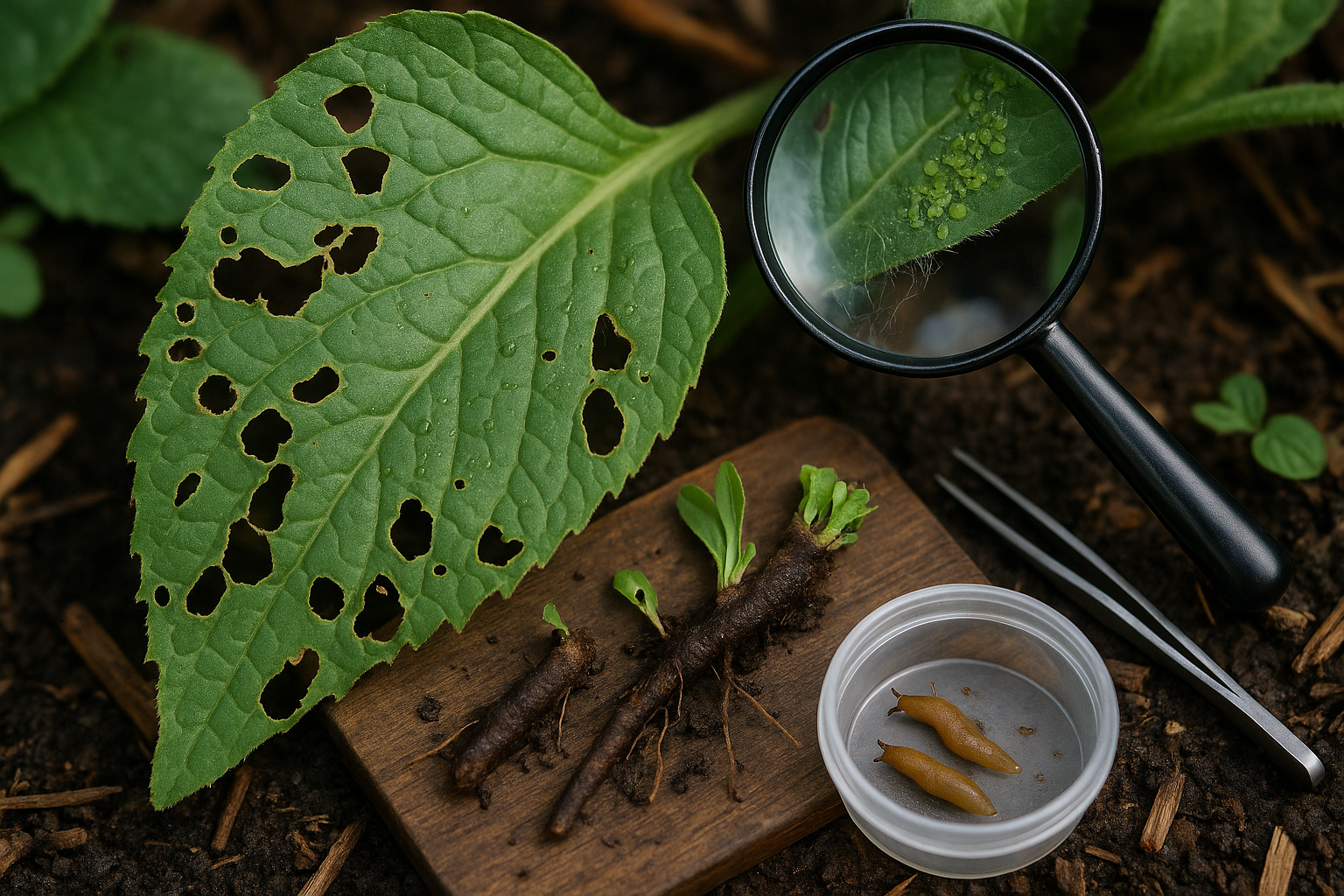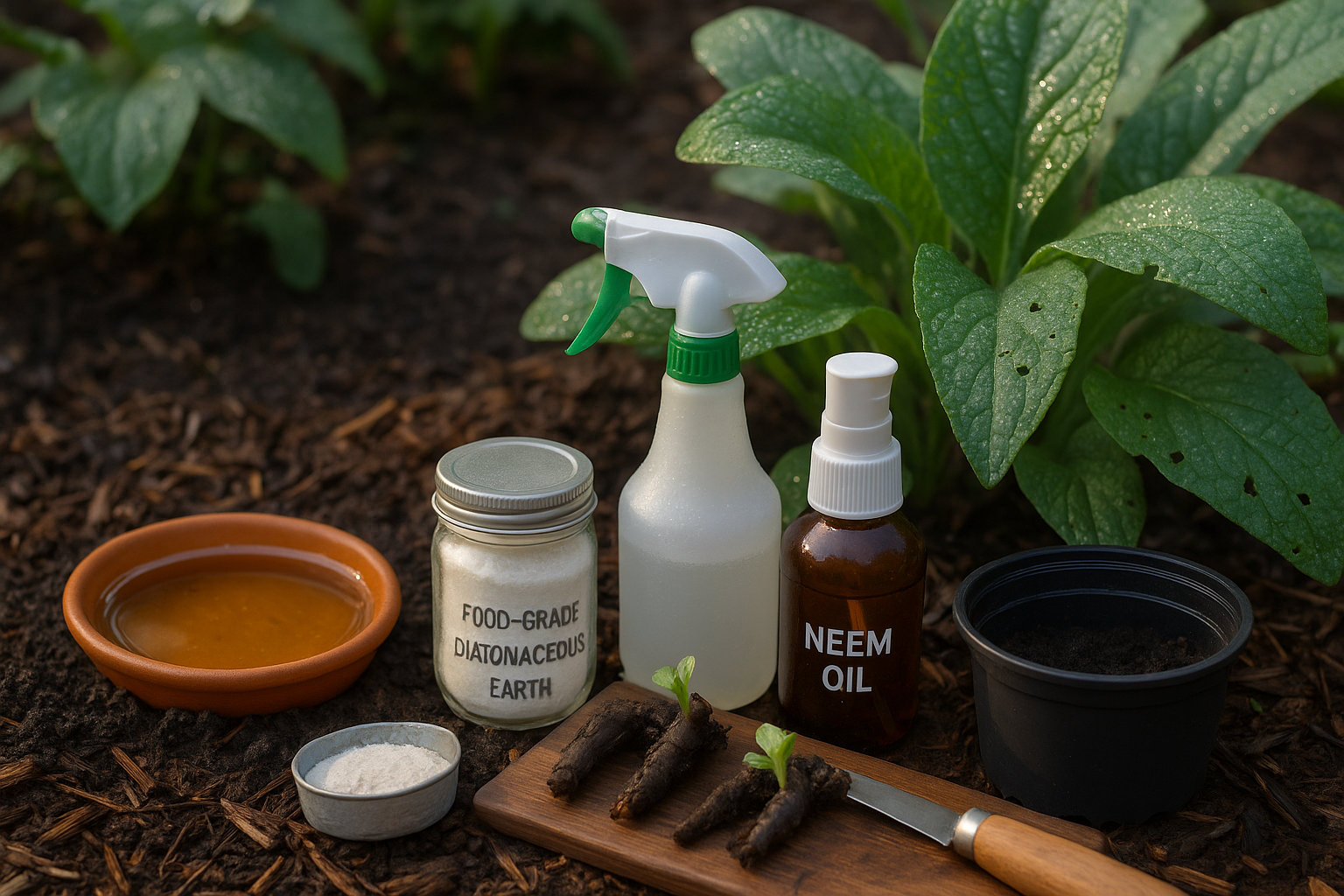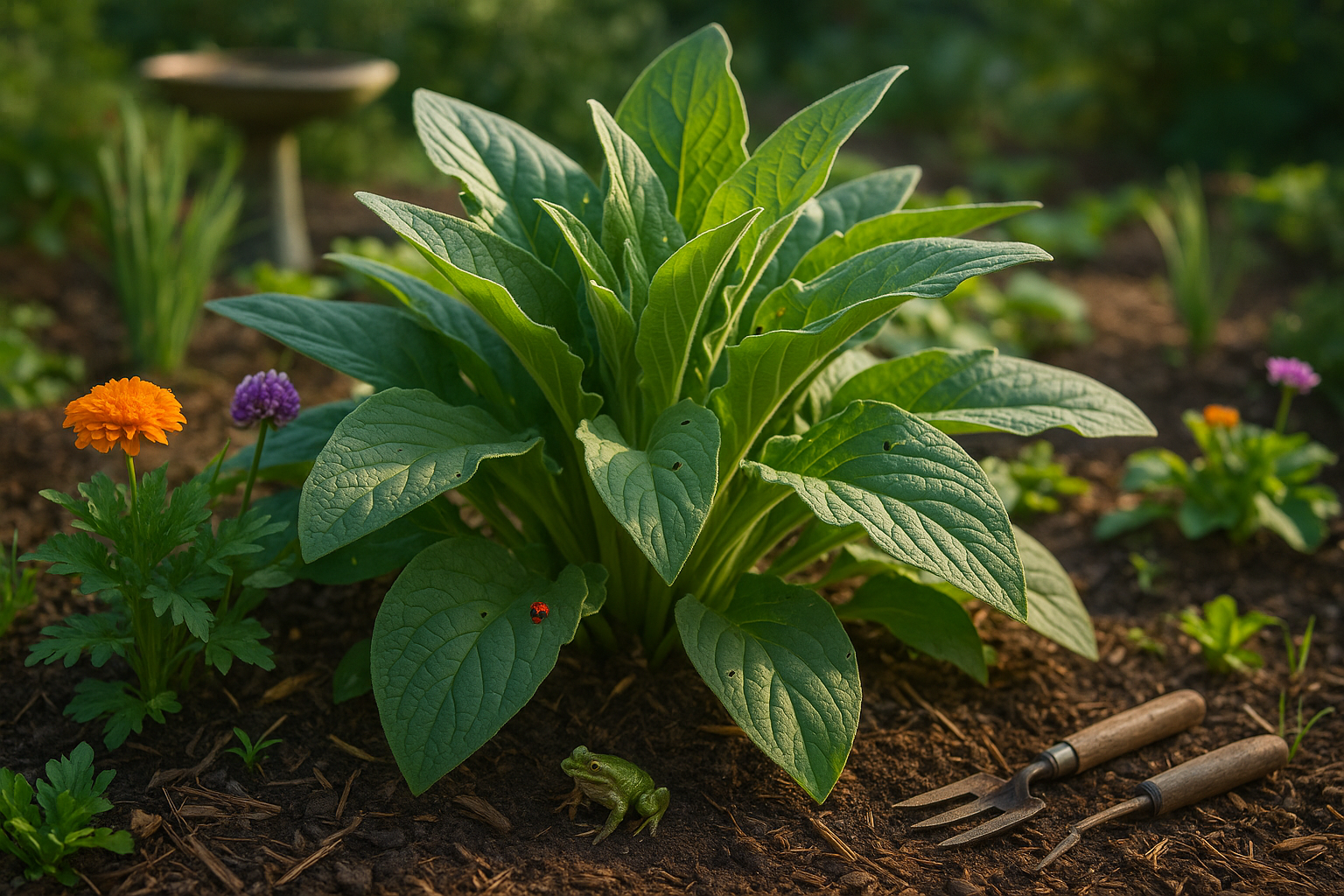“`html
Common Pests That Target Comfrey

Several pests are known to target comfrey, with the main culprits being slugs, snails, aphids, and spider mites. Slugs and snails are most active in damp conditions and are notorious for chewing irregular holes in comfrey leaves, often leaving slimy trails behind. Large infestations can skeletonize leaves overnight, especially on young plants.
Aphids—tiny green, black, or white insects—cluster on stems and the undersides of leaves, sucking sap and causing leaves to curl, wilt, or produce sticky honeydew. Ants often appear alongside aphids, attracted by this sweet residue.
Spider mites are harder to see without a magnifier but leave behind telltale signs: stippled, yellowing leaves; fine webbing between stems and leaves; and premature leaf drop during dry weather.
Less commonly, root-eating grubs or beetles may attack comfrey, leading to stunted plants or sudden wilting.
Identifying Pests
During routine garden inspections, look for:
- Holes and ragged edges on leaves (slugs/snails)
- Sticky residue or curling leaves (aphids)
- Yellow speckling or webbing (spider mites)
Accurate identification matters because treatments vary—removing slugs or snails by hand, blasting aphids with water, or boosting humidity to control spider mites all target specific pests. Mistaking a harmless visitor for a real pest can lead to unnecessary interventions that might harm beneficial insects.
Taking a moment to correctly identify what’s bugging your comfrey ensures more effective, environmentally friendly solutions—helping you keep your plants healthy and pest problems in check.
“`
Recognizing Pest Damage on Comfrey
Spotting pest damage on comfrey begins with observing visible signs like holes in the leaves, jagged or chewed edges, and a sticky residue called honeydew, often left by aphids. Unlike disease symptoms, which usually cause spots, discoloration, or mold, pest damage is characterized by irregular, missing sections of leaf tissue or clusters of small insects on stems and the undersides of leaves.
Nutrient deficiencies, in contrast, show up as overall yellowing or purpling of the leaves, without the physical chewing or presence of pests. To catch problems early, make a habit of inspecting your comfrey every few days, especially during warm, humid weather when pests are most active.
Check both sides of the leaves and around the plant base for any signs of insects or damage. Bringing a flashlight can help illuminate small pests hiding in crevices during evening checks. Early detection allows for quick intervention, minimizing long-term harm to your comfrey and keeping your plants lush and healthy.
Why Comfrey Is Usually Pest-Resistant
Comfrey stands out as a remarkably hardy, pest-resistant herb thanks to its tough, hairy leaves and rapid growth rate, which help deter many common garden pests. Its foliage produces natural compounds, including allantoin and rosmarinic acid, which are unappealing or toxic to insects and small herbivores. For example, most aphids, caterpillars, and slugs typically avoid comfrey in favor of more tender plants.
However, stress factors such as drought, overcrowding, or poor soil can weaken comfrey, making it more susceptible to infestations by pests like spider mites or rust fungi. It’s also possible to see comfrey occasionally affected by snails or sawfly larvae if nearby pest populations are high.
Fortunately, comfrey attracts an array of beneficial insects, including bees, predatory wasps, and ladybugs, which not only pollinate its prolific flowers but also feed on pests. Frogs and toads, often found in gardens with healthy comfrey, further assist by eating slugs and other small insects.
To maintain comfrey’s natural resistance, gardeners should provide well-drained soil, adequate space, and regular watering—simple steps that support both plant health and a balanced, pest-resilient ecosystem.
Organic Ways to Control Comfrey Pests

Controlling pests on comfrey organically is completely doable with a little effort and the right techniques. Start by hand-picking visible pests, such as slugs or caterpillars, early in the morning when they’re most active—drop them into a bucket of soapy water for quick control.
Setting up DIY beer traps around your comfrey patch can also help catch slugs and snails: simply bury a shallow container so the rim is level with the soil and fill it with beer—the pests are attracted by the smell and drown.
For tiny, soft-bodied bugs like aphids, dusting the leaves with food-grade diatomaceous earth acts as a barrier without harming the plants, but be sure to reapply after rain.
Homemade sprays can work wonders: use a mild soapy water mix (one teaspoon of unscented liquid soap per quart of water) to suffocate aphids or mites. Spray lightly on infested leaves in the early morning and rinse off a few hours later to avoid leaf damage.
Neem oil, diluted as instructed on the label, provides another natural solution; spray every 7-10 days, targeting the undersides of leaves where pests hide.
Meanwhile, promote pest resistance by interplanting comfrey with natural allies like marigolds, chives, or calendula—these companion plants confuse or repel many common pests.
Always be mindful not to overuse sprays or powders, even the natural types, since heavy applications can harm your comfrey’s leaves or disrupt helpful insects like bees and ladybugs.
By rotating these gentle methods and observing your plants regularly, you’ll maintain a healthy comfrey crop and safeguard the garden ecosystem.
Preventative Measures for a Pest-Free Comfrey Patch
Keeping your comfrey patch pest-free starts with simple, proactive habits in your daily gardening routine. Mulching is a smart first step; adding a layer of organic mulch around your plants not only conserves moisture but also acts as a barrier against crawling pests like slugs and snails.
Make sure to keep comfrey plants properly spaced—crowded patches trap humidity and encourage the spread of diseases and insect infestations. When you water, aim close to the soil rather than overhead, which helps prevent leaf rot and discourages pests that thrive in damp conditions.
Beyond these basics, encouraging garden biodiversity is a powerful natural defense. Interplant comfrey with flowering herbs like dill or yarrow, which attract beneficial insects while making it harder for pests to settle in. Inviting birds to your garden is as easy as installing a birdbath or hanging a feeder; these feathered friends will happily snack on pests.
Ladybugs are another helpful ally, and you can attract them by letting a few comfrey flowers bloom or planting nearby marigolds. Don’t forget seasonal upkeep—at the end of each growing season, clear away dead stems and debris to remove overwintering sites for insects. Rotating your comfrey patch every few years also disrupts pest life cycles and keeps soil healthy.
These small, mindful actions—mulching, maintaining variety, encouraging natural predators, and seasonal cleanup—add up to a vibrant, resilient comfrey garden with fewer pest problems.
When to Act
Keeping a close eye on your comfrey patch is key to catching pest issues early. Aim to check your plants at least once a week during the growing season, paying special attention to the undersides of leaves and around the base where pests often hide.
If you spot trouble—like clusters of aphids or chewed leaves—act fast with targeted treatments such as hand-picking, spraying with water, or applying organic pest controls.
To track what’s working, keep a simple garden journal. Record pest sightings, weather conditions, and any actions you take. Over time, these notes become valuable for spotting patterns and refining your strategy.
Build up your comfrey’s natural resilience by mulching to retain moisture, feeding with compost, and avoiding harsh chemicals that might weaken plants or harm helpful insects.
After each season, review your journal to celebrate wins and learn from what didn’t go as planned—maybe aphids peak after heavy rains, or a certain spray made a real difference.
Gradually, your observations will guide a responsive approach, helping you protect your comfrey, reduce future outbreaks, and become a more confident, attentive gardener year after year.
